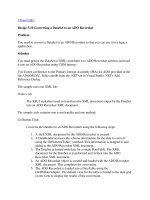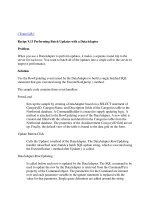Tài liệu Updating a DataSet with a Many-to-Many Relationship ppt
Bạn đang xem bản rút gọn của tài liệu. Xem và tải ngay bản đầy đủ của tài liệu tại đây (51.85 KB, 19 trang )
[ Team LiB ]
Recipe 4.10 Updating a DataSet with a Many-to-Many Relationship
Problem
You have a DataSet that contains two tables that have a many-to-many relationship
between them using a third junction table. You get referential integrity errors when you
try to update changes to the data in this DataSet back to the data source. You need to do
this successfully.
Solution
Use the techniques described in the discussion.
The schema of table TBL0410Parent used in this solution is shown in Table 4-5
.
Table 4-5. TBL0410Parent schema
Column name Data type Length Allow nulls?
ParentId int 4 No
Field1 nvarchar 50 Yes
Field2 nvarchar 50 Yes
The schema of table TBL0410Child used in this solution is shown in Table 4-6.
Table 4-6. TBL0410Child schema
Column name Data type Length Allow nulls?
ChildId int 4 No
Field3 nvarchar 50 Yes
Field4 nvarchar 50 Yes
The schema of table TBL0410ParentChild used in this solution is shown in Table 4-7.
Table 4-7. TBL0410ParentChild schema
Column name Data type Length Allow nulls?
ParentId int 4 No
ChildId int 4 No
The solution uses eleven stored procedures described in Table 4-8.
Table 4-8. Stored procedures for solution in Recipe 4.10
Name Description
SP0410_DeleteChild
Deletes the Child record specified by the ChildId input
parameter.
SP0410_DeleteParent
Deletes the Parent record specified by the ParentId input
parameter.
SP0410_DeleteParentChild
Deletes the ParentChild record specified by the ParentId
and ChildId input parameters.
SP0410_GetChild
Gets the Child record corresponding to the ChildId
specified or returns all Child records if no ChildId is
specified.
SP0410_GetParent
Gets the Parent record corresponding to the ParentId
specified or returns all Parent records if no ParentId is
specified.
SP0410_GetParentChild
Gets the ParentChild records corresponding to the ParentId
specified or returns all ParentChild records if no ParentId
is specified.
SP0410_InsertChild
Adds a new Child record. The stored procedure returns the
ChildId value generated by the data source as both an
output parameter and in the first returned record.
SP0410_InsertParent
Adds a new Parent record. The stored procedure returns the
ParentId value generated by the data source as both an
output parameter and in the first returned record.
SP0410_InsertParentChild Adds a new ParentChild record.
SP0410_UpdateChild Updates the Child record matching the specified ChildId.
SP0410_UpdateParent Updates the Parent record matching the specified ParentId.
The sample code contains five event handlers and four methods:
Form.Load
This event handler sets up the sample by creating a DataSet containing a parent,
child, and many-to-many junction table, as well as the DataRelation objects
between them. A DataAdapter object is created for each table and the stored
procedures to select, delete, insert, and update records in the data source are
specified for each. The LoadData( ) method is called to retrieve data for each table
in the DataSet. Finally, the default view for the parent and the child tables are
bound to data grids on the form.
LoadData( )
This method calls the Fill( ) method of the DataAdapter for each of the parent,
child, and junction tables.
CreateData( )
This method creates random data in both the parent and child tables and randomly
creates relationships between them by adding records to the junction table.
UpdateData( )
This method updates all changes in the DataSet back to the data source by calling
in the correct order the Update( ) method of the DataAdapter object for subsets of
the data in each of the parent, child, and junction tables.
Create Button.Click
This event handler calls the CreateData( ) method to add random data to the
DataSet.
Modify Button.Click
This event handler makes random changes to the data in the DataSet:
• Rows from the parent and child table are deleted or have values in their
fields modified.
• Parent/child relationships are eliminated by deleting records from the
junction table.
• The CreateData( ) method is called to create new data.
• The UpdateData( ) method is called to update all of the changes made to the
DataSet with the data source.
Delete Button.Click
This event handler deletes all data from the parent, child, and junction table. The
UpdateData( ) method is called to update the changes made to the DataSet with the
data source.
Refresh Button.Click
This event handler clears all data from the DataSet. LoadData( ) is then called to
load all data from the data source into the parent, child, and junction tables in the
DataSet.
The 11 stored procedures used in this example are shown in Example 4-13
through
Example 4-23
.
Example 4-13. Stored procedure: SP0410_DeleteChild
CREATE PROCEDURE SP0410_DeleteChild
@ChildId int
AS
SET NOCOUNT ON
delete
from
TBL0410Child
where
ChildId=@ChildId
return 0
Example 4-14. Stored procedure: SP0410_DeleteParent
CREATE PROCEDURE SP0410_DeleteParent
@ParentId int
AS
SET NOCOUNT ON
delete
from
TBL0410Parent
where
ParentId=@ParentId
return 0
Example 4-15. Stored procedure: SP0410_DeleteParentChild
CREATE PROCEDURE SP0410_DeleteParentChild
@ParentId int,
@ChildId int
AS
SET NOCOUNT ON
delete
from
TBL0410ParentChild
where
ParentId=@ParentId and
ChildId=@ChildId
return 0
Example 4-16. Stored procedure: SP0410_GetChild
CREATE PROCEDURE SP0410_GetChild
@ChildId int=null
AS
SET NOCOUNT ON
if @ChildId is not null
begin
select
ChildID,
Field3,
Field4
from
TBL0410Child
where
ChildId=@ChildId
return 0
end
select
ChildId,
Field3,
Field4
from
TBL0410Child
return 0
Example 4-17. Stored procedure: SP0410_GetParent
CREATE PROCEDURE SP0410_GetParent
@ParentId int=null
AS
SET NOCOUNT ON
if @ParentId is not null
begin
select
ParentId,
Field1,
Field2
from
TBL0410Parent
where
ParentId=@ParentId
return 0
end
select
ParentId,
Field1,
Field2
from
TBL0410Parent
return 0
Example 4-18. Stored procedure: SP0410_GetParentChild
CREATE PROCEDURE SP0410_GetParentChild
@ParentId int=null
AS
if @ParentId is not null
begin
select
ParentId,
ChildID
from
TBL0410ParentChild
where
ParentId=@ParentId
return 0
end
select
ParentId,
ChildID
from
TBL0410ParentChild
return 0
Example 4-19. Stored procedure: SP0410_InsertChild
CREATE PROCEDURE SP0410_InsertChild
@ChildId int output,
@Field3 nvarchar(50)=null,
@Field4 nvarchar(50)=null
AS
SET NOCOUNT ON
insert TBL0410Child(
Field3,
Field4)
values (
@Field3,
@Field4)
if @@rowcount=0
return 1
set @ChildId=Scope_Identity( )
select @ChildId ChildId
return 0
Example 4-20. Stored procedure: SP0410_InsertParent
CREATE PROCEDURE SP0410_InsertParent
@ParentId int output,
@Field1 nvarchar(50)=null,
@Field2 nvarchar(50)=null
AS
SET NOCOUNT ON
insert TBL0410Parent(
Field1,
Field2)
values (
@Field1,
@Field2)
if @@rowcount=0
return 1
set @ParentId=Scope_Identity( )
select @ParentId ParentId
return 0
Example 4-21. Stored procedure: SP0410_InsertParentChild
CREATE PROCEDURE SP0410_InsertParentChild
@ParentId int,
@ChildId int
AS
SET NOCOUNT ON
insert TBL0410ParentChild(
ParentId,
ChildId)
values (
@ParentId,
@ChildId)
if @@rowcount=0
return 1
return 0
Example 4-22. Stored procedure: SP0410_UpdateChild
CREATE PROCEDURE SP0410_UpdateChild
@ChildId int,
@Field3 nvarchar(50)=null,
@Field4 nvarchar(50)=null
AS
SET NOCOUNT ON
update
TBL0410Child
set
Field3=@Field3,
Field4=@Field4
where
ChildId=@ChildId
if @@rowcount=0
return 1
return 0
Example 4-23. Stored procedure: SP0410_UpdateParent
CREATE PROCEDURE SP0410_UpdateParent
@ParentId int,
@Field1 nvarchar(50)=null,
@Field2 nvarchar(50)=null
AS
SET NOCOUNT ON
update
TBL0410Parent
set
Field1=@Field1,
Field2=@Field2
where
ParentId=@ParentId
if @@rowcount=0
return 1
return 0
The C# code for updating a DataSet with a many-to-one relationship is shown in
Example 4-24.
Example 4-24. File: UpdateManyToManyRelationshipForm.cs
// Namespaces, variables, and constants
using System;
using System.Configuration;
using System.Windows.Forms;
using System.Data;
using System.Data.SqlClient;
private DataSet ds;
private SqlDataAdapter daParent, daParentChild, daChild;
private const String PARENTTABLENAME = "TBL0410Parent";
private const String PARENTCHILDTABLENAME = "TBL0410ParentChild";
private const String CHILDTABLENAME = "TBL0410Child";
// Table column name constants for Parent table
private const String PARENTID_FIELD = "ParentId";
private const String FIELD1_FIELD = "Field1";
private const String FIELD2_FIELD = "Field2";
// Table column parameter name constants for Child table
private const String CHILDID_FIELD = "ChildId";
private const String FIELD3_FIELD = "Field3";
private const String FIELD4_FIELD = "Field4";
// Stored procedure name constants
private const String DELETEPARENT_SP = "SP0410_DeleteParent";
private const String GETPARENT_SP = "SP0410_GetParent";
private const String INSERTPARENT_SP = "SP0410_InsertParent";
private const String UPDATEPARENT_SP = "SP0410_UpdateParent";
private const String DELETEPARENTCHILD_SP =
"SP0410_DeleteParentChild";
private const String GETPARENTCHILD_SP = "SP0410_GetParentChild";
private const String INSERTPARENTCHILD_SP =
"SP0410_InsertParentChild";
private const String DELETECHILD_SP = "SP0410_DeleteChild";
private const String GETCHILD_SP = "SP0410_GetChild";
private const String INSERTCHILD_SP = "SP0410_InsertChild";
private const String UPDATECHILD_SP = "SP0410_UpdateChild";
// stored procedure parameter name constants for Parent table
private const String PARENTID_PARM = "@ParentId";
private const String FIELD1_PARM = "@Field1";
private const String FIELD2_PARM = "@Field2";
// Stored procedure parameter name constants for Child table
private const String CHILDID_PARM = "@ChildId";
private const String FIELD3_PARM = "@Field3";
private const String FIELD4_PARM = "@Field4";
// . . .
private void UpdateManyToManyRelationshipForm_Load(object sender,
System.EventArgs e)
{
DataColumnCollection cols;
DataColumn col;
// Build the parent table.
DataTable parentTable = new DataTable(PARENTTABLENAME);
cols = parentTable.Columns;
col = cols.Add(PARENTID_FIELD, typeof(Int32));
col.AutoIncrement = true;
col.AutoIncrementSeed = -1;
col.AutoIncrementStep = -1;
cols.Add(FIELD1_FIELD, typeof(String)).MaxLength = 50;
cols.Add(FIELD2_FIELD, typeof(String)).MaxLength = 50;
// Build the ParentChild table.
DataTable parentChildTable = new DataTable(PARENTCHILDTABLENAME);
cols = parentChildTable.Columns;
cols.Add(PARENTID_FIELD, typeof(Int32)).AllowDBNull = false;
cols.Add(CHILDID_FIELD, typeof(Int32)).AllowDBNull = false;
parentChildTable.PrimaryKey = new DataColumn[]
{cols[PARENTID_FIELD], cols[CHILDID_FIELD]};
// Build the child table.
DataTable childTable = new DataTable(CHILDTABLENAME);
cols = childTable.Columns;
col = cols.Add(CHILDID_FIELD, typeof(Int32));
col.AutoIncrement = true;
col.AutoIncrementSeed = -1;
col.AutoIncrementStep = -1;
cols.Add(FIELD3_FIELD, typeof(String)).MaxLength = 50;
cols.Add(FIELD4_FIELD, typeof(String)).MaxLength = 50;
// Add the tables to the DataSet and create the relationship.
ds = new DataSet( );
ds.Tables.Add(parentTable);
ds.Tables.Add(parentChildTable);
ds.Tables.Add(childTable);
ds.Relations.Add(new DataRelation("Parent_ParentChild",
parentTable.Columns[PARENTID_FIELD],
parentChildTable.Columns[PARENTID_FIELD], true));
ds.Relations.Add(new DataRelation("Child_ParentChild",
childTable.Columns[CHILDID_FIELD],
parentChildTable.Columns[CHILDID_FIELD], true));
// Create the Parent DataAdapter.
daParent = new SqlDataAdapter(GETPARENT_SP,
ConfigurationSettings.AppSettings["Sql_ConnectString"]);
daParent.SelectCommand.CommandType = CommandType.StoredProcedure;
// Build the parent delete command.
SqlCommand deleteCommand = new SqlCommand(DELETEPARENT_SP,
daParent.SelectCommand.Connection);
deleteCommand.CommandType = CommandType.StoredProcedure;
deleteCommand.Parameters.Add(PARENTID_PARM, SqlDbType.Int, 0,
PARENTID_FIELD);
daParent.DeleteCommand = deleteCommand;
// Build the parent insert command.
SqlCommand insertCommand = new SqlCommand(INSERTPARENT_SP,
daParent.SelectCommand.Connection);
insertCommand.CommandType = CommandType.StoredProcedure;
insertCommand.Parameters.Add(PARENTID_PARM, SqlDbType.Int, 0,
PARENTID_FIELD);
insertCommand.Parameters.Add(FIELD1_PARM, SqlDbType.NVarChar, 50,
FIELD1_FIELD);
insertCommand.Parameters.Add(FIELD2_PARM, SqlDbType.NVarChar, 50,
FIELD2_FIELD);
daParent.InsertCommand = insertCommand;
// Build the parent update command.
SqlCommand updateCommand = new SqlCommand(UPDATEPARENT_SP,
daParent.SelectCommand.Connection);
updateCommand.CommandType = CommandType.StoredProcedure;
updateCommand.Parameters.Add(PARENTID_PARM, SqlDbType.Int, 0,
PARENTID_FIELD);
updateCommand.Parameters.Add(FIELD1_PARM, SqlDbType.NVarChar, 50,
FIELD1_FIELD);
updateCommand.Parameters.Add(FIELD2_PARM, SqlDbType.NVarChar, 50,
FIELD2_FIELD);
daParent.UpdateCommand = updateCommand;
// Create the Child DataAdapter.
daChild = new SqlDataAdapter(GETCHILD_SP,
ConfigurationSettings.AppSettings["Sql_ConnectString"]);
daChild.SelectCommand.CommandType = CommandType.StoredProcedure;
// Build the child delete command.
deleteCommand = new SqlCommand(DELETECHILD_SP,
daChild.SelectCommand.Connection);
deleteCommand.CommandType = CommandType.StoredProcedure;
deleteCommand.Parameters.Add(CHILDID_PARM, SqlDbType.Int, 0,
CHILDID_FIELD);
daChild.DeleteCommand = deleteCommand;
// Build the child insert command.
insertCommand = new SqlCommand(INSERTCHILD_SP,
daChild.SelectCommand.Connection);
insertCommand.CommandType = CommandType.StoredProcedure;
insertCommand.Parameters.Add(CHILDID_PARM, SqlDbType.Int, 0,
CHILDID_FIELD);
insertCommand.Parameters.Add(FIELD3_PARM, SqlDbType.NVarChar, 50,
FIELD3_FIELD);
insertCommand.Parameters.Add(FIELD4_PARM, SqlDbType.NVarChar, 50,
FIELD4_FIELD);
daChild.InsertCommand = insertCommand;
// Build the child update command.
updateCommand = new SqlCommand(UPDATECHILD_SP,
daChild.SelectCommand.Connection);
updateCommand.CommandType = CommandType.StoredProcedure;
updateCommand.Parameters.Add(CHILDID_PARM, SqlDbType.Int, 0,
CHILDID_FIELD);
updateCommand.Parameters.Add(FIELD3_PARM, SqlDbType.NVarChar, 50,
FIELD3_FIELD);
updateCommand.Parameters.Add(FIELD4_PARM, SqlDbType.NVarChar, 50,
FIELD4_FIELD);
daChild.UpdateCommand = updateCommand;
// Create the ParentChild DataAdapter.
daParentChild = new SqlDataAdapter(GETPARENTCHILD_SP,
ConfigurationSettings.AppSettings["Sql_ConnectString"]);
daParentChild.SelectCommand.CommandType = CommandType.StoredProcedure;
// Build the ParentChild delete command.
deleteCommand = new SqlCommand(DELETEPARENTCHILD_SP,
daParentChild.SelectCommand.Connection);
deleteCommand.CommandType = CommandType.StoredProcedure;
deleteCommand.Parameters.Add(PARENTID_PARM, SqlDbType.Int, 0,
PARENTID_FIELD);
deleteCommand.Parameters.Add(CHILDID_PARM, SqlDbType.Int, 0,
CHILDID_FIELD);
daParentChild.DeleteCommand = deleteCommand;
// Build the ParentChild insert command.
insertCommand = new SqlCommand(INSERTPARENTCHILD_SP,
daParentChild.SelectCommand.Connection);
insertCommand.CommandType = CommandType.StoredProcedure;
insertCommand.Parameters.Add(PARENTID_PARM, SqlDbType.Int, 0,
PARENTID_FIELD);
insertCommand.Parameters.Add(CHILDID_PARM, SqlDbType.Int, 0,
CHILDID_FIELD);
daParentChild.InsertCommand = insertCommand;
LoadData( );
dataGridParent.DataSource = parentTable.DefaultView;
dataGridChild.DataSource = childTable.DefaultView;
}
private void LoadData( )
{
// Fill the dataset.
daParent.Fill(ds, PARENTTABLENAME);
daChild.Fill(ds, CHILDTABLENAME);
daParentChild.Fill(ds, PARENTCHILDTABLENAME);
}
private void CreateData(int parentRows, int childRows)
{
// Create some data update the data source with it.
for(int iParent = 0; iParent < parentRows; iParent++)
{
DataRow parentRow = ds.Tables[PARENTTABLENAME].NewRow( );
parentRow[FIELD1_FIELD] = Guid.NewGuid().ToString( );
parentRow[FIELD2_FIELD] = Guid.NewGuid().ToString( );
ds.Tables[PARENTTABLENAME].Rows.Add(parentRow);
}
for(int iChild = 0; iChild < childRows; iChild++)
{
DataRow childRow = ds.Tables[CHILDTABLENAME].NewRow( );
childRow[FIELD3_FIELD] = Guid.NewGuid().ToString( );
childRow[FIELD4_FIELD] = Guid.NewGuid().ToString( );
ds.Tables[CHILDTABLENAME].Rows.Add(childRow);
}
// Randomly create the parent-child relationships.
Random r = new Random((int)DateTime.Now.Ticks);
foreach(DataRow rowParent in ds.Tables[PARENTTABLENAME].Rows)
{
if(rowParent.RowState != DataRowState.Deleted)
{
foreach(DataRow rowChild in
ds.Tables[CHILDTABLENAME].Rows)
{
if(rowChild.RowState != DataRowState.Deleted &&
r.Next(2) == 1)
{
// Check to see that row doesn't exist
// before adding.
if(ds.Tables[PARENTCHILDTABLENAME].
Rows.Find(new object[]
{rowParent[PARENTID_FIELD],
rowChild[CHILDID_FIELD]}) == null)
{
ds.Tables[PARENTCHILDTABLENAME].
Rows.Add(new object[]
{rowParent[PARENTID_FIELD],
rowChild[CHILDID_FIELD]});
}
}
}
}
}
}
private void UpdateData( )
{
try
{
daParentChild.Update(ds.Tables[PARENTCHILDTABLENAME].Select(
null, null, DataViewRowState.Deleted));
daChild.Update(ds.Tables[CHILDTABLENAME].Select(
null, null, DataViewRowState.Deleted));
daParent.Update(ds.Tables[PARENTTABLENAME].Select(
null, null, DataViewRowState.Deleted));
daParent.Update(ds.Tables[PARENTTABLENAME].Select(
null, null, DataViewRowState.ModifiedCurrent));
daParent.Update(ds.Tables[PARENTTABLENAME].Select(
null, null, DataViewRowState.Added));
daChild.Update(ds.Tables[CHILDTABLENAME].Select(
null, null, DataViewRowState.ModifiedCurrent));
daChild.Update(ds.Tables[CHILDTABLENAME].Select(
null, null, DataViewRowState.Added));
daParentChild.Update(ds.Tables[PARENTCHILDTABLENAME].Select(
null, null, DataViewRowState.Added));
}
catch (Exception ex)
{
MessageBox.Show(ex.Message);
}
}
private void createDataButton_Click(object sender, System.EventArgs e)
{
// Create parent and child records.
CreateData(4,4);
UpdateData( );
MessageBox.Show("Data created.","Many-to-Many Relationships",
MessageBoxButtons.OK, MessageBoxIcon.Information);
}
private void modifyButton_Click(object sender, System.EventArgs e)
{
Random r = new Random((int)DateTime.Now.Ticks);
// Randomly delete or modify rows from the child and parent rows.
for(int i = ds.Tables[CHILDTABLENAME].Rows.Count; i > 0; i )
{
DataRow childRow = ds.Tables[CHILDTABLENAME].Rows[i - 1];
if(r.Next(2) == 0)
{
childRow[FIELD3_FIELD] = Guid.NewGuid().ToString( );
childRow[FIELD4_FIELD] = Guid.NewGuid().ToString( );
}
else
childRow.Delete( );
}
for(int i = ds.Tables[PARENTTABLENAME].Rows.Count; i > 0; i )
{
DataRow parentRow = ds.Tables[PARENTTABLENAME].Rows[i - 1];
if(r.Next(2) == 0)
{
parentRow[FIELD1_FIELD] = Guid.NewGuid().ToString( );
parentRow[FIELD2_FIELD] = Guid.NewGuid().ToString( );
}
else
parentRow.Delete( );
}
// Randomly delete m-n parent/child relationships.
for(int i = ds.Tables[PARENTCHILDTABLENAME].Rows.Count; i > 0; i )
{
DataRow parentChildRow =
ds.Tables[PARENTCHILDTABLENAME].Rows[i - 1];
if(r.Next(2) == 0)
parentChildRow.Delete( );
}
// Insert two rows into Parent, Child, and random ParentChild.
CreateData(2,2);
UpdateData( );
MessageBox.Show("Data randomly modified.",
"Many-to-Many Relationships", MessageBoxButtons.OK,
MessageBoxIcon.Information);
}
private void deleteButton_Click(object sender, System.EventArgs e)
{
// Delete the Parent records.
for(int i = ds.Tables[PARENTTABLENAME].Rows.Count; i > 0 ;i )
ds.Tables[PARENTTABLENAME].Rows[i - 1].Delete( );
// Delete the Child records.
for(int i = ds.Tables[CHILDTABLENAME].Rows.Count; i > 0; i )
ds.Tables[CHILDTABLENAME].Rows[i - 1].Delete( );
// Delete the ParentChild records.
for(int i = ds.Tables[PARENTCHILDTABLENAME].Rows.Count; i > 0 ;i )
ds.Tables[PARENTCHILDTABLENAME].Rows[i - 1].Delete( );
UpdateData( );
MessageBox.Show("Data deleted.", "Many-to-Many Relationships",
MessageBoxButtons.OK, MessageBoxIcon.Information);
}
private void refreshButton_Click(object sender, System.EventArgs e)
{
ds.Clear( );
LoadData( );
}
Discussion
To avoid referential integrity problems when updating a data source with changes in a
DataSet having tables related with a many-to-many relationship, update the rows in the
following order:
1. Deleted junction rows
2. Deleted child rows
3. Deleted parent rows
4. Updated parent rows
5. Inserted parent rows
6. Updated child rows
7. Inserted child rows
8. Inserted junction rows
Pass DataViewRowState.Deleted into the Select( ) method of the DataTable object to get
the subset of deleted rows from a table. Similarly, pass DataViewRowState.Added to
obtain inserted rows and DataViewRowState.ModifiedCurrent to obtain modified rows.
A few more considerations involving the primary key:
• If the primary key cannot be modified once added, the updated and inserted rows
can be processed in the same statement. Pass a bitwise combination into the select
method as shown here:
• daParent.Update(ds.Tables[PARENTTABLENAME].Select(null, null,
DataViewRowState.Added | DataViewRowState.ModifiedCurrent));
• If the primary key can be modified, the database must cascade the updated primary
key values to the child records; otherwise, a referential integrity violation will
occur. If the foreign key is used as part of the concurrency handling process, the
UpdateCommand property of child tables must accept either its Original or the
Current value.
• If the primary key is an AutoIncrement value and its value is generated by the
database, the InsertCommand must return the primary key value from the data
source and use it to update the value in the DataSet. The DataSet will then
automatically cascade this new value to the child records.
[ Team LiB ]









